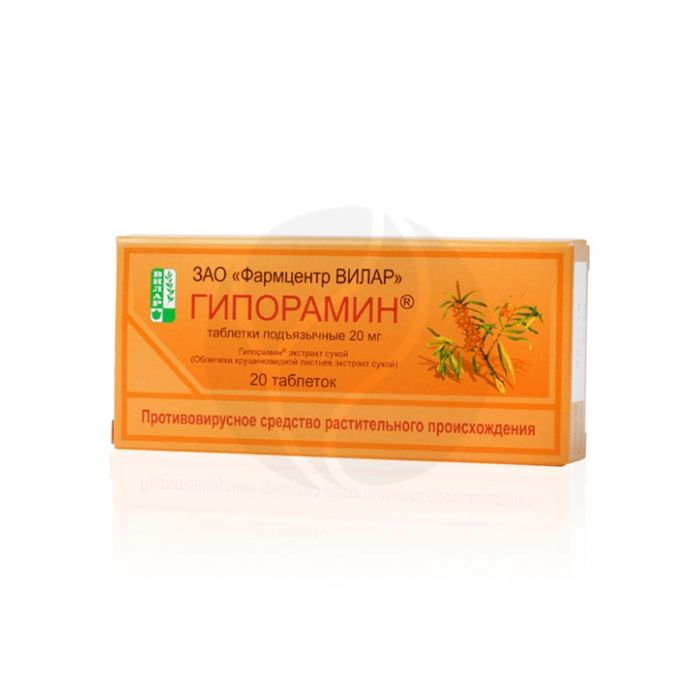Hyporamine tablets 20mg, No. 20
Expiration Date: 05/2027
Russian Pharmacy name:
Гипорамин таблетки 20мг, №20
As a therapeutic and prophylactic agent:
with flu (A and B),
parainfluenza,
PC viral,
adenovirus and other acute respiratory viral infections;
with tonsillitis occurring against the background of acute respiratory viral diseases (complex therapy);
with acute and recurrent forms of herpes simplex extragenital and genital localization; with shingles, chickenpox and CMV infection
Treatment. Hyporamine tablets sublingual 1 tablet (20 mg) are kept in the mouth until they are completely absorbed. Adults and children over 12 years old are prescribed 1 tablet (20 mg) 4-6 times a day, children 6-12 years old - 1 tablet (20 mg) 3-4 times a day, children 3-6 years old - 1 / 2 tablets (10 mg) 2-4 times a day.
The duration of use is from 3 days to 3 weeks, depending on the nosological form of the disease.
With flu - at least 3 days; with parainfluenza, PC-viral, adenoviral infections, tonsillitis occurring against the background of acute respiratory viral diseases (complex therapy), and other acute respiratory viral infections - at least 5 days.
With chickenpox, shingles, herpesvirus and CMV infections, the duration of use depends on the severity of the process and is 3-10 days in milder forms of the disease.
In severe and recurrent forms of the disease - the minimum course of treatment is 2-3 weeks. Repeated courses of treatment are advisable.
For prophylaxis during an outbreak of influenza, Hyporamine sublingual tablets are taken in accordance with age-specific dosages from 3 days to 3 weeks. As a prophylactic agent to prevent the development of viral complications (herpesvirus diseases and CMV infection) during immunosuppressive therapy in postoperative patients, in risk groups, Hyporamine in the form of sublingual tablets (20 mg) is used 3 times a day for 5-7 days.
Sublingual tablets
1 tab. dry purified extract from the leaves of sea buckthorn (Hippophae rhamnoides) 20 mg
children under 3 years of age (taking into account the solid dosage form of the tablet);
deficiency of sucrase / isomaltase, fructose intolerance, glucose-galactose malabsorption;
hypersensitivity to the components of the drug.
With care: diabetes mellitus.
pharmachologic effect
Hyporamine is a dry purified extract from the leaves of sea buckthorn (Hippophae rhamnoides L.) of the loch family (Elaeagnaceae), which is a polyphenolic complex of galloellagotannins, the biologically active components of which are hydrolyzable tannins, which have common structural elements in the form of glucose-haloylipheno-hexahydroxyl residues. Hyporamine has high antiviral activity against various strains of influenza A and B viruses, adenoviruses, paramyxoviruses, herpes simplex viruses, shingles, cytomegalovirus (CMV), respiratory syncytial virus (RS virus), human immunodeficiency viruses (HIV infection). The inhibitory effect of the drug on the reproduction of viruses is manifested in the early stages of their development.One of the mechanisms of action of the drug is an inhibitory effect on viral neuraminidase. Hyporamine induces the production of interferon in blood cells in in vitro experiments and increases the content of interferon in the blood of patients. The drug in in vitro experiments also has a moderate antimicrobial effect against gram-positive (Staphylococcus aureus) and gram-negative bacteria (Escherichia coll, Proteus vulgaris, Pseudomonas aeruginosa), mycobacterium tuberculosis (Mycobacterium tuberculosis), candida ). Hyporamine has low toxicity. Does not possess allergenic, immunotoxic, mutagenic, teratogenic and carcinogenic properties.The drug in in vitro experiments also has a moderate antimicrobial effect against gram-positive (Staphylococcus aureus) and gram-negative bacteria (Escherichia coll, Proteus vulgaris, Pseudomonas aeruginosa), mycobacterium tuberculosis (Mycobacterium tuberculosis), candida ). Hyporamine has low toxicity. Does not possess allergenic, immunotoxic, mutagenic, teratogenic and carcinogenic properties.The drug in in vitro experiments also has a moderate antimicrobial effect against gram-positive (Staphylococcus aureus) and gram-negative bacteria (Escherichia coll, Proteus vulgaris, Pseudomonas aeruginosa), mycobacterium tuberculosis (Mycobacterium tuberculosis), candida ). Hyporamine has low toxicity. Does not possess allergenic, immunotoxic, mutagenic, teratogenic and carcinogenic properties.Does not possess allergenic, immunotoxic, mutagenic, teratogenic and carcinogenic properties.Does not possess allergenic, immunotoxic, mutagenic, teratogenic and carcinogenic properties.
Side effect
Allergic reactions are possible.
Application during pregnancy and lactation
During pregnancy and breastfeeding, the use of the drug is possible if the intended benefit to the mother outweighs the potential risk to the fetus and child.
Application in children
Contraindicated in children under 3 years of age. Children from 2 months to 3 years old are prescribed lyophilized hyporamine for solutions of 0.02 g in the form of an aqueous solution - nasal drops, inhalation.
special instructions
Hyporamine is prescribed at the earliest possible stage of the disease. The most pronounced therapeutic effect is achieved with a combination of medicinal forms of the drug of general resorptive and local action (rectal and / or vaginal suppositories with hyporamine 0.05 g (for adults); ointment for local and external use 0.5%; lyophilized hyporamine for solutions 0, 02 g in the form of an aqueous solution - nasal drops, inhalation). 1 tablet of the drug contains 0.5539 g of carbohydrates, which corresponds to 0.046 XE. Patients with diabetes mellitus should take the drug after consulting a doctor. Use in pediatrics Children from 2 months to 3 years old are prescribed lyophilized hyporamine for solutions of 0.02 g in the form of an aqueous solution - nasal drops, inhalation.
Influence on the ability to drive vehicles and use mechanisms
The drug does not affect the performance of potentially hazardous activities that require an increased concentration of attention and speed of psychomotor reactions (including driving, working with moving mechanisms).
Overdose
To date, no cases of drug overdose have been registered. With prolonged use in doses exceeding those indicated in the instructions, an increase in blood clotting is possible. Treatment: symptomatic.
Drug interactions
It is possible to use the drug in combination with other drugs (antimicrobial agents, synthetic antiviral agents, agents for symptomatic therapy).

